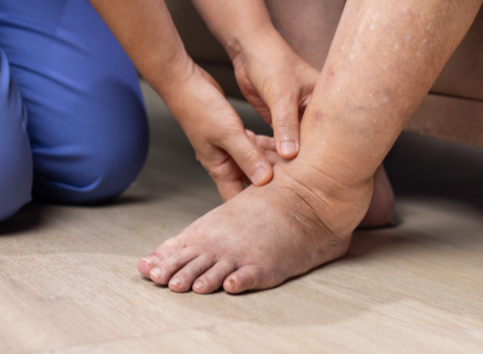Lipoedema: Everything you need to know
Published 4 Aug 2025 • By Somya Pokharna
Why do some women develop painful, heavy legs that no amount of diet or exercise can fix? The answer may be lipoedema, a chronic and often misunderstood fat disorder that affects up to 11% of women. Despite its prevalence, it’s frequently mistaken for obesity or lymphedema, leading to years of frustration without a proper diagnosis.
Lipoedema causes more than cosmetic concern. It can lead to pain, mobility issues, and emotional distress, but with the right care, symptoms can be managed.
So what causes lipoedema, and why is it so often overlooked? How is it diagnosed, and what treatment options truly work?
Find all the answers in this article!

What is lipoedema?
Lipoedema is a long-term medical condition that causes an abnormal build-up of fat, usually in the legs and sometimes in the arms. Unlike regular weight gain, the fat in lipoedema is symmetrical and painful, and it does not respond to diet or exercise. The hands and feet are typically unaffected, which helps distinguish lipoedema from other conditions like lymphedema.
Although lipoedema is sometimes confused with obesity, it is a separate disorder with its own symptoms, causes, and treatments. It affects women almost exclusively and is thought to be severely underdiagnosed due to lack of awareness in the medical community.
The condition can significantly impact quality of life, leading to physical discomfort, restricted mobility, and emotional distress. Many women go years without a diagnosis, often being told their symptoms are simply due to excess weight or poor lifestyle choices.
What causes lipoedema? Can it be prevented?
Hormonal influences
Lipoedema almost always develops during periods of hormonal change, most commonly puberty, pregnancy, or menopause. This strongly suggests that female sex hormones, particularly estrogen, play a role in triggering the condition or worsening its symptoms.
Genetic predisposition
Many women with lipoedema report a family history of similar symptoms. Research suggests an autosomal dominant inheritance pattern with incomplete penetrance, meaning it can be passed down through generations but doesn’t always appear in every carrier.
Connective tissue and vascular abnormalities
Some researchers believe that weaknesses in connective tissue and blood or lymphatic vessels may contribute to lipoedema. The fat in affected areas is thought to be more fibrotic and inflamed, and there may be increased capillary fragility and lymphatic dysfunction.
Can lipoedema be prevented?
Currently, there is no known way to prevent lipoedema. Because it is likely influenced by genetics and hormones, lifestyle changes alone cannot stop it from developing. However, early detection and symptom management may help delay its progression.
Maintaining a healthy lifestyle, with balanced nutrition, regular physical activity, and weight management, can improve overall health, support joint function, and reduce the risk of complications such as obesity or lipo-lymphoedema, but it will not cure or prevent lipoedema itself.
What are the symptoms of lipoedema?
Lipoedema symptoms often begin gradually and can worsen over time if left untreated. The condition primarily affects the lower body, though the upper arms may also be involved. Here are the key signs and symptoms:
- Symmetrical swelling of the legs (and sometimes arms), with sparing of the hands and feet
- Pain or tenderness in the affected areas, especially when touched or pressed
- Heaviness or tightness in the limbs, often worsening throughout the day
- Easy bruising, even after minor trauma or without clear cause
- Fat deposits that do not respond to diet or exercise
- Soft or nodular fat texture, which may feel lumpy under the skin
- Cuffing effect at the ankles or wrists, where swelling abruptly stops
- Cold skin over the affected areas
- Emotional symptoms, such as body image distress, anxiety, or depression
These symptoms are often misunderstood or misattributed to general obesity, which can delay diagnosis. Many women report feeling dismissed by healthcare professionals before receiving a correct diagnosis.
How is lipoedema diagnosed?
Lipoedema is diagnosed clinically, which means there’s no blood test or scan that can confirm it. Instead, a knowledgeable healthcare provider will rely on a detailed medical history and physical examination.
Key diagnostic clues include:
- Symmetrical fat distribution in the legs or arms,
- Sparing of the feet and hands,
- Pain or tenderness in the affected areas,
- Family history of similar symptoms,
- Onset during hormonal transitions.
To help standardize diagnosis and care, Dutch medical guidelines recommend using a minimum data set (MDS). This includes assessments of pain levels, mental health, physical functioning, and how the condition impacts daily life. They also recommend using the International Classification of Functioning (ICF) to evaluate the effects of lipoedema on a patient’s mobility, social participation, and emotional wellbeing.
Because lipoedema is often mistaken for obesity or lymphedema, it’s important to rule out other conditions. Unlike lymphedema, lipoedema does not cause pitting (where an indent remains after pressing on the skin), and the Stemmer sign (the ability to pinch the skin on the toe) is usually negative.
What are the stages and types of lipoedema?
Lipoedema is a progressive condition that can worsen over time. It is usually categorized into stages and types based on severity and location:
Stage 1 — The skin appears smooth, but the underlying fat is thickened and painful
Stage 2 — The fat becomes more fibrous and nodular, giving the skin a lumpy or uneven texture
Stage 3 — Significant swelling and fat deposits, often leading to folds of skin and impaired mobility
Stage 4 — Development of secondary lymphedema, known as lipo-lymphedema
Types of lipoedema are based on where the fat accumulates. Some women may have fat only in their hips and thighs, while others may also have involvement in the arms. In some cases, the lower legs are affected, but the feet remain unaffected, creating the distinctive “cuff” at the ankles.
How is lipoedema treated and managed?
There is currently no cure for lipoedema, but there are effective treatments to manage symptoms and slow progression. First-line treatment is always conservative, aiming to reduce pain, improve mobility, and support emotional wellbeing.
Compression therapy
Special garments or bandages can help reduce swelling and provide support to painful tissues. Manual lymphatic drainage, a type of gentle massage, may improve lymph flow and ease discomfort.
Exercise
Activities like swimming, walking, or yoga are often recommended because they’re low-impact and help with circulation and joint health. Even though lipoedema fat doesn’t respond to calorie restriction, maintaining a healthy weight is still important, especially to prevent coexisting conditions like obesity or cardiovascular disease.
Psychological support
Living with a misunderstood condition can be isolating and emotionally draining. Talking to a therapist or joining a support group can make a big difference in coping with the challenges of daily life.
Surgical approaches
In more severe cases, tumescent liposuction may be considered. This procedure removes excess fat while preserving surrounding structures like blood vessels and lymphatics. It’s currently the only surgical option with evidence of long-term benefit in reducing pain and improving quality of life. However, it should only be performed in specialized centres and requires long-term postoperative care, including compression therapy and physical rehabilitation.
What is the outlook for someone with lipoedema?
Lipoedema is a chronic condition, but with the right support and treatment, many people can lead full and active lives. Early diagnosis and conservative management can help slow the condition’s progression and relieve many of its symptoms.
That said, the journey is not always easy. Many women with lipoedema face years of misdiagnosis or stigma before finding answers. Others struggle with the emotional toll of a visible, painful condition that limits their daily activities.
But change is happening. Growing awareness, improved diagnostic tools, and new research into hormonal and genetic causes are offering hope. Patient advocacy groups and online communities are also empowering individuals to seek proper care and support.
While there’s still much to learn, one thing is clear: lipoedema is real, it’s manageable, and no one living with it should feel ignored or alone.
Did you find this article helpful?
Give it a “Like” and share your thoughts and questions with the community in the comments below!
Take care!
Sources:
Bauer AT, von Lukowicz D, Lossagk K, et al. New Insights on Lipedema: The Enigmatic Disease of the Peripheral Fat. Plast Reconstr Surg. 2019;144(6):1475-1484.
Buso G, Depairon M, Tomson D, Raffoul W, Vettor R, Mazzolai L. Lipedema: A Call to Action!. Obesity (Silver Spring). 2019;27(10):1567-1576.
Canning C, Bartholomew JR. Lipedema. Vasc Med. 2018;23(1):88-90.
Dudek, J.E., Białaszek, W. & Gabriel, M. Quality of life, its factors, and sociodemographic characteristics of Polish women with lipedema. BMC Women's Health 21, 27 (2021).
Fonder MA, Loveless JW, Lazarus GS. Lipedema, a frequently unrecognized problem. J Am Acad Dermatol. 2007;57(2 Suppl):S1-S3.
Halk AB, Damstra RJ. First Dutch guidelines on lipedema using the international classification of functioning, disability and health. Phlebology. 2017 Apr;32(3):152-159.
Herbst KL, Kahn LA, Iker E, et al. Standard of care for lipedema in the United States. Phlebology. 2021;36(10):779-796.
Kruppa P, Georgiou I, Biermann N, Prantl L, Klein-Weigel P, Ghods M. Lipedema-Pathogenesis, Diagnosis, and Treatment Options. Dtsch Arztebl Int. 2020;117(22-23):396-403.
Torre YS, Wadeea R, Rosas V, Herbst KL. Lipedema: friend and foe. Horm Mol Biol Clin Investig. 2018;33(1)
Vyas A, Adnan G. Lipedema. [Updated 2023 Jan 30]. In: StatPearls [Internet]. Treasure Island (FL): StatPearls Publishing.
Warren Peled A, Kappos EA. Lipedema: diagnostic and management challenges. Int J Womens Health. 2016;8:389-395.

 Facebook
Facebook Twitter
Twitter

